Want more traffic to your store?
We’ll check your SEO, give simple tips, and set up a quick call to talk.
Most eCommerce brands try to shortcut SEO by copying what already ranks. A Shopify skincare store borrows a fashion label’s keyword strategy, duplicates the content structure, and follows the same posting rhythm. Yet the rankings stay exactly where they were.
Then comes the frustration: “We did everything right. Why isn’t it working?”
The truth is simple. Google doesn’t reward imitation. It rewards contextual relevance.
SEO today isn’t about copying what performs for someone else. It is about alignment, connecting your content to your niche, search intent, and customer journey within your unique eCommerce ecosystem.
Modern eCommerce SEO runs on original data and intent-driven strategy, not replication. The brands that grow are those that sound like themselves, not like the competition.
This article explains how your website’s structure can make SEO problems worse and how you can fix it to gain an edge over competitors.
Every niche has its own ranking DNA
This is where most SEO strategies fall apart.
Every niche operates on its own ranking DNA, the unique mix of signals that Google values within that specific market. The same tactics do not carry the same weight everywhere.
Take backlinks, for example. In some industries, they are everything. In others, they barely move the needle.
If you are working with a local business such as a plumber or therapist, you might see top-ranking pages with fewer than 50 referring domains. But for an eCommerce store, you will often need hundreds links to compete.
That concept forms what we call the Link Dependency Index, the level of link power your niche demands before Google begins to trust your domain.
Then there is the Signal Weight Distribution, the hidden hierarchy Google uses to decide which ranking factors matter most within each industry.
In fashion eCommerce, for instance, image optimization and content freshness tend to carry more influence. In electronics or tech, authority and technical depth usually dominate.
Understanding that balance is what separates a strategy built on context from one built on copy-paste assumptions.
Niche | Avg. RDs (Top 3) | Avg. Words/Page | Dominant Signal |
Skincare | 400 | 1,800 | E-E-A-T + reviews |
Apparel | 250 | 1,500 | Visual optimization |
Supplements | 2,000 | 2,200 | Links + authority |
Gadgets | 1,200 | 2,000 | Technical depth |
So before you chase someone else’s strategy, ask yourself this. Does your niche even respond to the same signals?
Because ranking well in your industry isn’t about doing more SEO. It’s about understanding which levers actually move the needle in your niche.
The competitor signal analysis method
Now that you understand every niche has its own ranking DNA, the next step is to uncover what drives that DNA.
This is where the Competitor Signal Analysis Method comes in.
It is the same process we use inside Semrush when analyzing what makes a site rank in competitive eCommerce categories. The goal is to identify the dominant ranking signals your competitors are leaning on, then quantify which of those signals actually move the needle in your niche.
The method is simple, practical, and grounded in data, not assumptions.
It takes the guesswork out of optimization by showing you exactly where to invest effort, whether that means strengthening your backlink profile, improving topical authority, or tuning on-page signals that your market values most.
Let’s walk through it.
Step 1: Identify the real competitors
Forget Domain Authority. Start with real traffic.
In Semrush, go to Organic Research, enter your domain, and click on the Competitors tab.
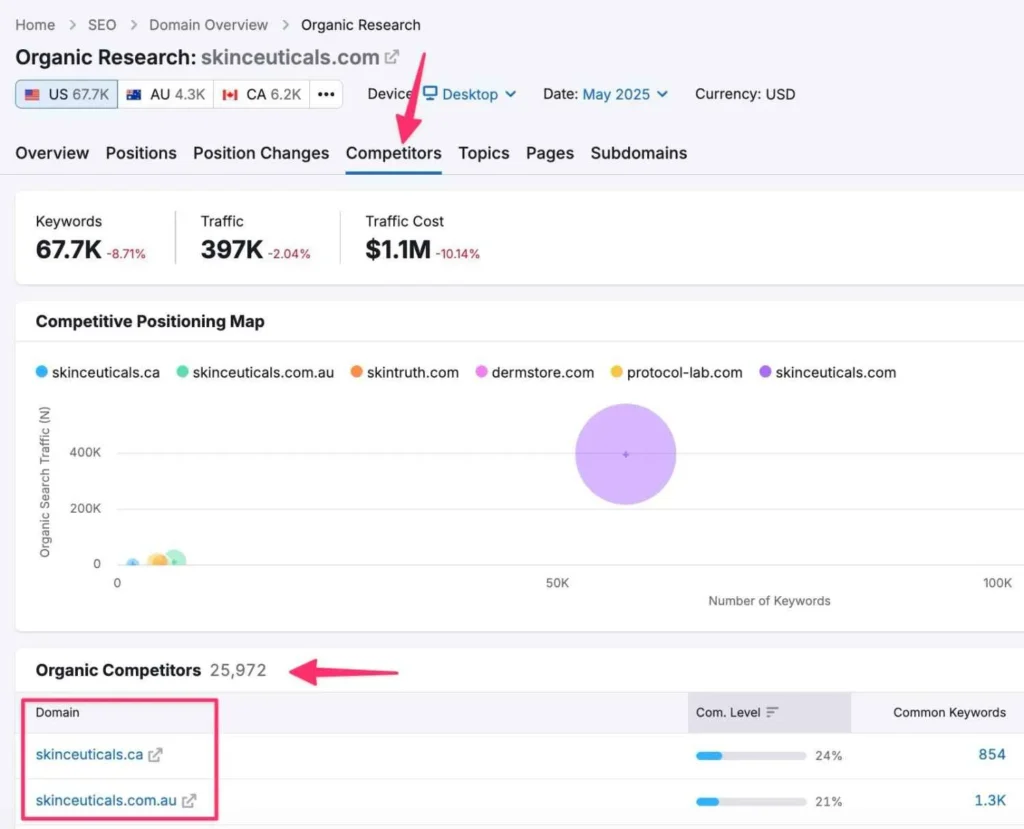
You’ll instantly see which sites actually pull organic traffic in your space.
Pick the top three with consistent traffic growth, not just high authority.
Traffic shows who’s winning right now, not who looks powerful on paper.
You can cross-check the same competitors in Ahrefs if you want deeper coverage.
Step 2: Reverse-engineer link velocity
Open each competitor in Semrush’s Backlink Analytics.
Go to the Referring Domains graph and SEMrush will show last 6 months data. Also add this these filter – ‘Active’ and ‘Follow’.

Note: This is a big brand most of the Referring Domains comming organically.
Have a look at another brand’s link profile.
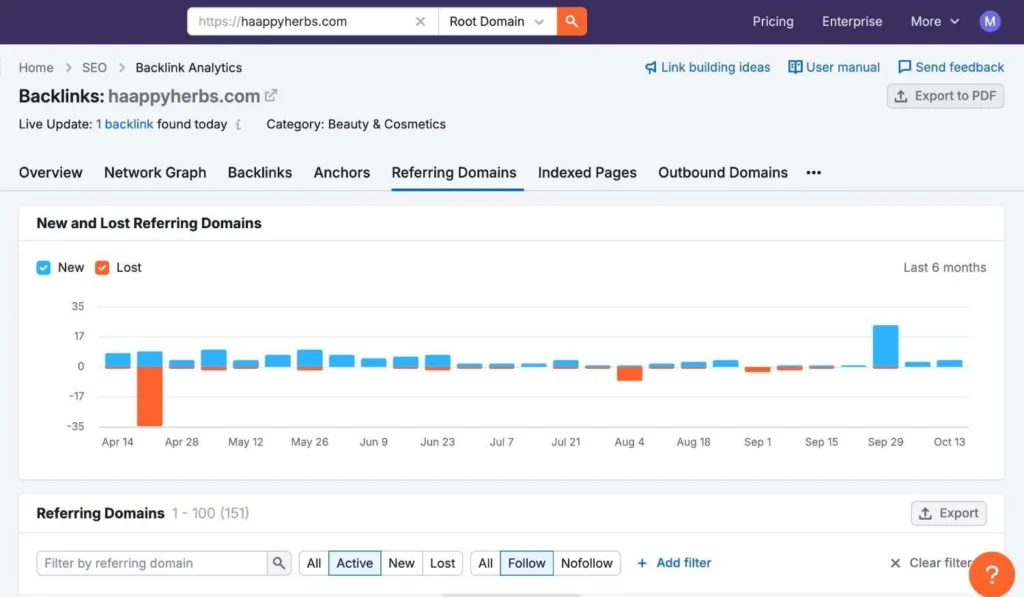
Now you calculate your Link Velocity Score using this simple metric:
Link Velocity = New Referring Domains ÷ Months
If your competitors are adding 25 to 30 new domains per month and you’re adding five, you’re not keeping up with the link growth Google expects in that niche.
Momentum matters more than totals.
Step 3: Map content production cycles
Here’s a practical method that works even with Semrush’s one-month window:
1. Open the “Pages” Report
Go to Organic Research → Pages. Set the date to today.
2. Look at the “Traffic Diff.” column

Pages showing new traffic (+100, +200, etc.) or now ranking for keywords are likely new or newly optimized.
3. Export the data and add filter for “Traffic Diff. > 0”
This narrows down to only pages that gained visibility this month.
Save it with the month’s name (e.g., Oct_2025_Pages.csv).
4. Repeat this next month
In November, run the same export (Nov_2025_Pages.csv).
5. Compare the exports
In Excel or Google Sheets, check which URLs are newly appearing in November’s export but weren’t in October’s.
- Those are your newly ranking (likely newly published) pages.
- Count them to estimate how many pages your competitor published that month.
Step 4: Decode anchor text strategy
In Semrush, open the Backlink Anchors tab for each competitor.
Notice the mix between branded, commercial, and informational anchors.
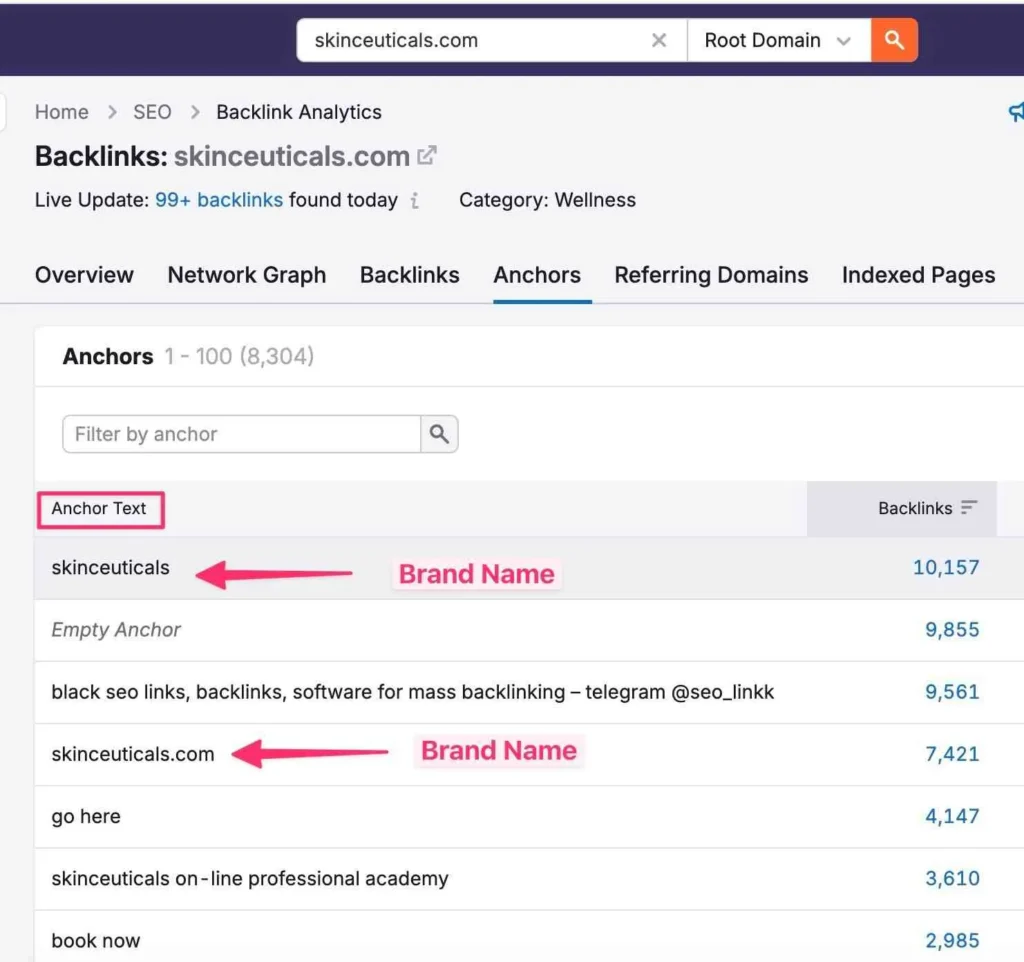
If you see the above anchor text, there has some spam anchor black seo links, software for mass backlinks, etc. which are non related to that site.
Note: If you hire someone, ensure your backlink provider understands proper anchor text management. Otherwise it will destroy your site.
We follow this ratior: roughly 60% branded, 20% generic, 20% product-related
If your anchors lean too commercial compared to your competitors, you’re signalling manipulation instead of trust.
Step 5: Observe UX indicators
Many SEOs overlook this part, but Google doesn’t.
It watches how people behave on your site. If visitors spend more time, scroll deeper, and click to explore more pages, it signals that your content meets intent.
Strong engagement tells Google your titles and H1s align with what users searched for, your content is readable, and your layout helps them find answers fast.
When these signals combine with solid authority and publishing consistency, you start ranking not just because of links but because people actually stay.
Invisible factors that break copy-paste SEO
Even after you match keywords, links, and content cadence, your site can still lag behind.
That’s because some of the biggest ranking factors don’t live inside your SEO tool. They hide in how your brand behaves, how users interact, and how fast you can move.
Let’s unpack the invisible side of SEO that breaks the copy-paste approach.
UX and CRO debt
This one quietly kills rankings. You can have high authority and strong backlinks, but if your product pages frustrate users, Google notices.
Think about it. A user clicks your result, lands on your page, can’t find what they need, and jumps back to Google. That’s pogo-sticking.

If that happens too often, Google assumes your page failed to complete the task.
From what I’ve seen in client data, if your bounce rate crosses 60% on key product pages, your rankings eventually slip. It’s not immediate, but it compounds over time.
CRO and UX don’t just affect conversion. They influence how Google interprets satisfaction.
Hidden cost of competition
Not every market demands the same level of SEO effort. Data from Ahrefs shows that ranking in competitive YMYL (Your Money or Your Life) niches like health and finance often requires 10x more referring domains than in lifestyle or apparel categories.
For example, an apparel brand we worked with reached page one for several mid-volume keywords after building around 40 quality backlinks and publishing two optimized guides a month. But a supplement brand in the same timeframe, despite identical content quality and technical setup, needed over 300 referring domains and consistent weekly publishing before moving into the top ten.
The difference wasn’t skill. It was market dynamics. Competitors in health and fitness publish faster, attract backlinks more aggressively, and operate in a much higher ‘link economy’.
That’s why SEO success depends on matching your niche’s competitive pace. If others in your space produce weekly content and attract dozens of links monthly while your strategy operates at a fraction of that rhythm, rankings will stall no matter how solid your on-page work is.
Indexing speed
Some domains publish a new page and see it indexed within hours. Others wait days. That delay can quietly destroy topical momentum.
Fast-indexing sites usually have stronger crawl equity, meaning Google trusts them enough to visit frequently and process new content faster.
We saw this firsthand while working with two eCommerce clients.
- A Shopify apparel brand with a clean internal link structure and frequent content updates had new collection pages indexed within 6 to 12 hours of publishing.
- A supplement store, despite having a larger backlink profile, took 3 to 5 days for similar pages to appear in the index.
The difference came down to crawl signals. The apparel brand used consistent internal linking to surface new URLs, maintained a fresh sitemap, and kept its homepage updated with the latest products. The supplement site, on the other hand, buried new pages several clicks deep and didn’t refresh its sitemap often.
You can track your own indexing pace in Google Search Console’s Indexing Report. If new collection or blog pages consistently take several days to appear, you’re already losing freshness points before the competition even begins.
Topical speed and the power of clusters
This is where most smaller stores fall behind. Big brands don’t just publish one blog a month. They build topic clusters.
Adding 10 to 12 new pages each month around connected keyword groups helps them dominate a niche’s entire semantic field.
Topical speed is how quickly you can expand your topical map, not just how often you post. The faster you cover subtopics, interlink them, and reinforce your main entities, the harder it becomes for new competitors to catch up.
Take an example from the skincare space. A mid-sized DTC brand started with one high-quality article targeting ‘retinol serum benefits’. 6 months later, they had expanded into a full cluster with 15 connected pages:
- Core topic: Retinol serum benefits
- Supporting topics: retinol vs bakuchiol, retinol for acne, retinol for beginners, retinol concentration guide, side effects of retinol, how to layer retinol with vitamin C
- Commercial nodes: product landing pages linked contextually from educational guides
Each page linked to others with contextual anchors like “check our beginner’s guide to retinol” or “compare retinol strengths here.”
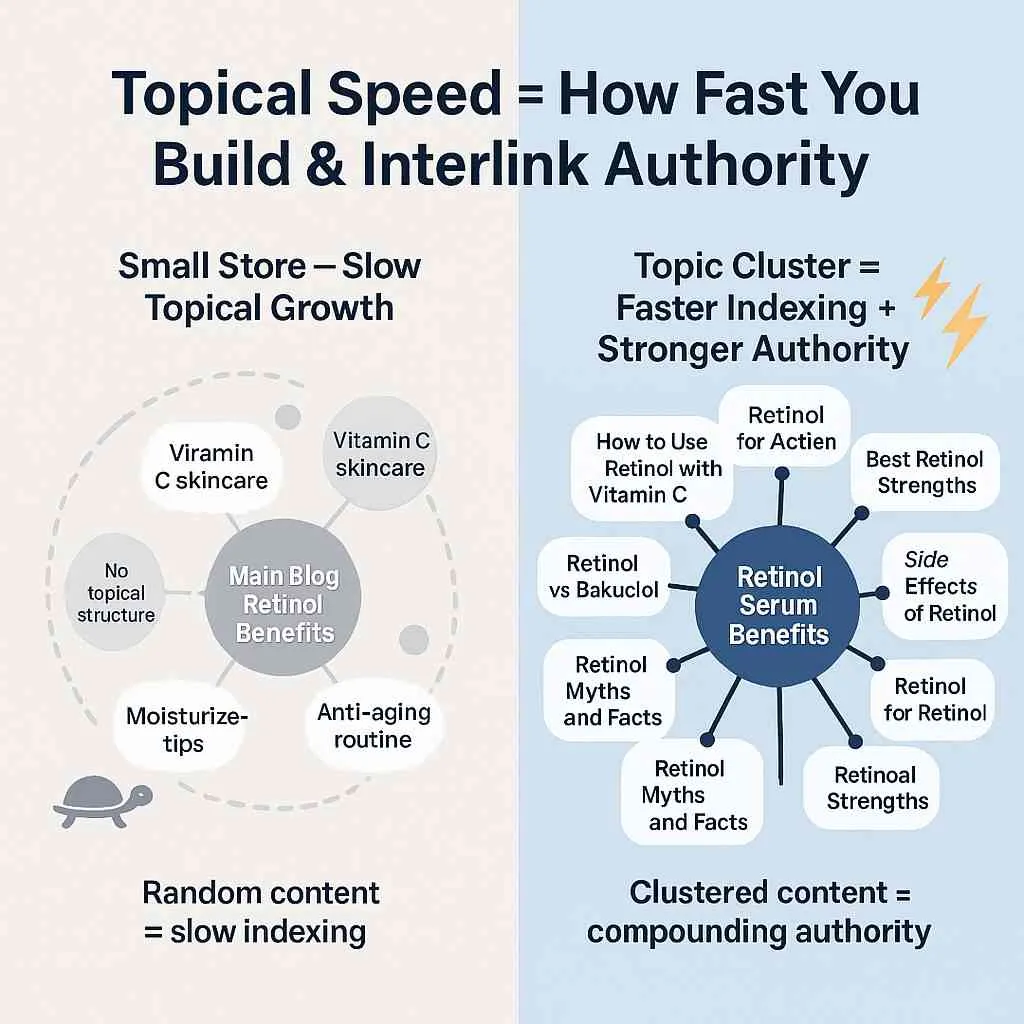
Within ninety days, this single cluster started ranking for over 800 long-tail variations and captured 60% of total blog traffic. Competitors that published one-off articles on retinol couldn’t match the coverage depth or link structure. Google began recognizing the brand as an entity-level authority on retinol-based skincare, leading to faster indexing, higher E-E-A-T signals, and improved crawl frequency across the site.
That’s topical speed in action. It’s not about how many articles you publish, but how fast you expand and connect the ideas that define your niche.
So when someone copies a competitor’s SEO plan without matching their UX, budget, crawl equity, or topical speed, it’s like trying to run a marathon in slow motion. The structure looks the same, but the engine isn’t there.
Competitor Analysis ≠ Strategy
Competitor data gives you the baseline, not the blueprint. It shows you where the market stands, not how to stand out.
That’s where most people stop. They collect the data, build pretty graphs, and copy what’s already ranking. But real SEO growth starts when you see what your competitors have missed.
Data tells you what exists. Strategy is what you do with what’s missing.
We actually tested this with one of our skincare clients. During the audit, we noticed something interesting. Every competitor’s FAQ schema looked identical. The same four questions repeated across every product page:
“How do I use this product?”, “Is it suitable for all skin types?”, “Does it contain parabens or sulfates?”, and “How long will it take to see results?”
Google could easily tell those FAQs were copy-pasted templates, not real answers to search intent.
So instead of repeating the same pattern, we built product-specific FAQs based on what people were actually searching for.
Questions like “Is this Vitamin C serum safe to use with retinol?”, “Can this clay mask help reduce acne for oily skin?”, and “What’s the best routine order to apply this hyaluronic acid?”, came directly from Semrush keyword data and People Also Ask results.
We added those as structured FAQ schema for each product page.
Within a few weeks, our listings started earning rich results with expanded FAQs under the snippets.
The pages took up more space on the SERP and pushed competitors down. Click-through rates went up by 10% without adding a single new backlink.
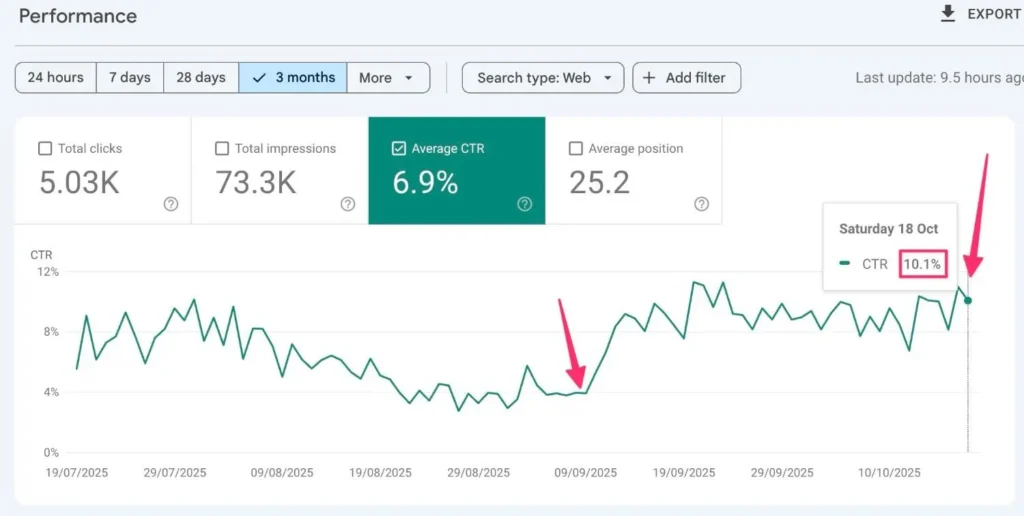
That small change proved something important. SEO growth doesn’t come from copying what everyone else is doing.
It comes from finding the blind spots your competitors overlook and turning them into opportunities Google actually values.
Building your niche-specific SEO roadmap
Once you understand your niche’s ranking DNA and what signals actually move the needle, it’s time to turn that insight into a plan.
Here’s how we usually build a roadmap for clients that keeps SEO predictable, measurable, and tied to growth.
Step 1: Audit your top three competitors
Start with the ones driving real traffic, not just those with high authority scores.
In Semrush, look at their backlinks, content publishing rhythm, and UX signals.
You’ll notice patterns quickly. Some niches rely heavily on content freshness, while others win purely on link momentum or product experience.
This becomes your baseline, your real-world benchmark.
Step 2: Quantify your gap metrics
Now measure where you stand against them.
Check your monthly link velocity, content cadence, and indexing speed.
If a competitor adds 25 new referring domains a month and you’re adding 10, your growth rate is 40% slower.
If they publish 8 new contents a month and you publish 2, that’s a 75% content velocity gap.
Write these numbers down. Treat them like your SEO scoreboard.
Step 3: Think higher than your competitors
Don’t aim to match their metrics; aim to exceed them by at least 20%.
If they’re earning 25 links a month, your goal should be 30.
If they post eight new pages, make it ten.
That extra 20% adds up over time and helps you move past the point where most competitors stop growing.
Step 4: Add your differentiators
Here’s where strategy takes over.
Layer in what competitors aren’t doing, things Google can’t replicate with metrics alone.
Build product-led content that ties directly to what you sell, like “How to style linen shirts for humid weather” or “Best skincare routines for monsoon season”.
Use first-party data, like customer reviews or survey insights, to create original content that can’t be found anywhere else.
Encourage UGC, especially photo or video reviews. It strengthens trust signals and drives engagement metrics Google actually tracks.
When we applied this for one of our apparel clients, their average keyword positions improved by 32% in 4 months.
The content itself didn’t just rank, it converted, because it was built from real buyer intent rather than keyword volume.
Step 5: Reevaluate every 90 days
SEO changes too fast for static strategies. Every 3 months, rerun the same framework, competitor audit, metric tracking, and gap analysis.
When you do this consistently, you stop reacting to Google updates and start predicting them. Your SEO roadmap should never be a copy of someone else’s path.
It should be your niche’s data, your audience’s behavior, and your own creative advantage working together.
That’s how you build an SEO system that scales, not just survives.
Conclusion: SEO is contextual, not universal
SEO isn’t a one-size-fits-all playbook. What works for a fashion brand won’t move the needle for skincare or supplements.
At SEOglaze, we help eCommerce brands build SEO strategies that fit their niche and their audience, not someone else’s. From fixing product-level crawl issues to building content that drives real conversions, every move is data-backed and context-driven.
If you’re ready to grow your store organically and want a clear, tailored roadmap for your niche, book a free strategy call with us.
Because in eCommerce, rankings don’t build revenue. Relevance does.

